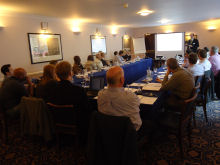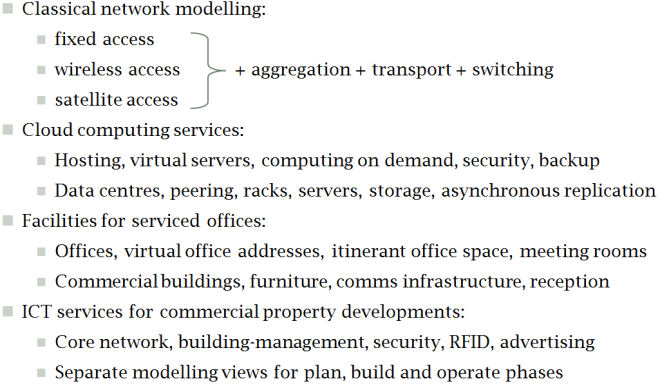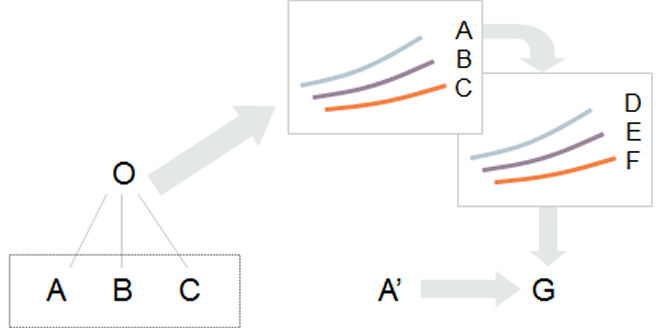The 15th STEM User Group Meeting was held at King’s College, Cambridge, UK from 5–6 October 2010.
 The well-attended event also served as the formal launch of Implied Logic Limited
in its role as new owner of the STEM visual software for the reliable modelling of business. Fittingly,
the audience for the event was also up for the second year running, reflecting an
increasing trend of activity in the business-modelling field. Operators are trying
to size-up inevitable investment realities – reduce opex and survive, or invest
to enable new services and markets – and are starting to show increasing distrust
of, and discomfort with, bespoke spreadsheet solutions.
The well-attended event also served as the formal launch of Implied Logic Limited
in its role as new owner of the STEM visual software for the reliable modelling of business. Fittingly,
the audience for the event was also up for the second year running, reflecting an
increasing trend of activity in the business-modelling field. Operators are trying
to size-up inevitable investment realities – reduce opex and survive, or invest
to enable new services and markets – and are starting to show increasing distrust
of, and discomfort with, bespoke spreadsheet solutions.
In this article we review the programme of the STEM User Group event, and conclude
with a cross-section of audience profiles. The full proceedings may be downloaded
from the panel accompanying this text on our website.
Capex and opex work-out
In the headline session on capex, Robin Bailey (Managing Director, informally known
as ‘Mr STEM’) did a walkthrough of the core inputs and results for modelling capital
expenditures, and the different options for depreciation, before expanding on some
recent extensions which have been made in response to ongoing customer requirements.
The session was rounded off with an exposition by Frank Haupt (Expert Practitioner)
on the practical challenges of matching calculated depreciation to exact accounting
numbers from an existing asset register which has been subject to periodic asset
re-valuation.
The first opex session (on day two) explored some existing techniques for calculating
activity-based costs related to a demand-driven model of operational processes for
installation and maintenance. In the follow-up session, Implied Logic talked through
some development proposals to remove various timing ambiguities which impact the modelling
and calculation of one-off installation drivers.

Figure 1: Secondary support resources and opex breakdown
Showcase
The first showcase session presented a summary of recent projects in telecoms and
some ventures into wider trends such as cloud computing services and IT infrastructure
for commercial property development. We are now able to demonstrate that the STEM
modelling process is eminently suited to a wide range of applications beyond telecoms,
in line with Implied Logic’s mission to broaden the user and topic base for STEM.

Figure 2: A progression from networks to information technology
The second showcase reverted to core telecoms issues, with an idealised requirement
for calculating costs associated with network routing and port allocation on a linear
network. Optical add/drop multiplexers (OADMs) are used to add and drop optical
paths at nodes along a trunk route, raising the tantalising question: ‘Can a template
[for an individual node] drive itself?’ The slightly contrived solution demonstrated
to the audience is based on a recursive template technique which you may not want
to try at home!

Figure 3: a short, linear network uses OADMs to add and drop optical paths at nodes along a trunk route.
Software development and support
Session 3 (on day one) set out some new development priorities. Based on a slew
of projects in the last 12 months, Robin Bailey has committed to a vision for a
next STEM version driven largely by his ‘notes in the margin’ from working with
clients. Whatever grander ideas remain on the roadmap, it is a clear priority to
ease, remove or re-design a range of interface ‘gotchas’ which are not significant
individually, but collectively stand in the way of a new user being able to advance
quickly with the software.
Experienced users who have already survived need not feel neglected: a whole new
results paradigm was explored, from options to modify in situ the contents of a
graph through to some longer term ideas for an icon-driven results browser integrated
with the STEM model editor.

Figure 4: Graphing the members of a collection of model elements.
In the final session, nominally billed as a question-and-answer modelling surgery,
Implied Logic presented three support case studies, giving a good insight into the
‘sharp end’ of modelling, and how Implied Logic provides a range of support services,
from advice and bug fixing, through to new feature enhancement in order to support
its clients’ activities to the full.
Implied Logic mission
The last session on day one provided a potted history of the development of Implied
Logic Limited to date, and allowed extended discussion of its future priorities
and general strategy (see separate article). The objective of reaching out to new
partners was warmly welcomed by the audience, and we provide a few illustrative
profiles of the attendees to help you decide whether this event would be of interest
to you in the future:
|
Profile
|
Interest
|
|
Telecoms, planning, new recruit
|
getting a feel for the software
|
|
Vendor, existing modeller
|
broadening awareness
|
|
Public sector, director
|
keeping abreast of latest thinking
|
|
Independent consultant
|
reviewing alternative modelling techniques
|
|
Infrastructure player, development director
|
discovering key planning issues in FTTH
|
|
Vendor, director
|
hearing about other clients’ activities
|
|
Converged telco, planning manager
|
finding out about accelerated modelling techniques
|
|
Vendor, professional services
|
validate interest in STEM for customer solution modelling
|
|
Industry consultant, seasoned modeller
|
learning new tricks
|
Figure 5: Illustrative profiles of STEM User Group Meeting attendees.
The 16th annual STEM User Group Meeting will be on the same dates, and at the same
King’s College venue, but this time Wednesday–Thursday 5–6 October 2011.
Open training
Eight clients stayed on for two days of open training at Implied Logic’s office
in Histon, Cambridge, informally planned in the weeks leading up to the User Group
event itelf. Delegates hurried through a telescoped, basic course of exercises on
our standard training model, The business case for WiMAX vs DSL in rural areas,
on day one, before engaging in a hands-on live modelling workshop on day two.
To a rather hastily drawn-up and rough-and-ready definition of a mobile network operator,
we established a workable market segmentation and service structure by lunch time,
and then added replication of the core calculations for separate geo-types and scenarios
for various potential technology shifts in the afternoon.

Figure 6: Rough and ready mobile market segmentation and service structure.
Fundamental building blocks
The objective was limited to learning and practice, but it was clear to all attendees
just how much could be achieved in a single day by a group of strangers with a cool
modelling tool and paradigm.
Compare that familiar open canvas of a bespoke spreadsheet – which can do anything, right or wrong, very well.